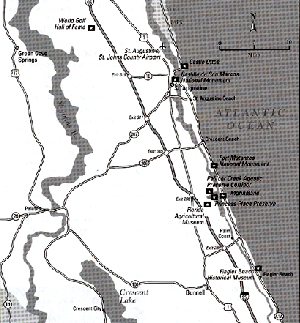
San Agustín, St. Augustine (1) |
 |
|---|
Sources: The map in the left box helps us situate St. Augustine on a rough contemporary map within a region that goes from the Atlantic Ocean to Palatka and from the World Golf Hall of Fame to Lake George. Note that this map shows the central portion of what is called the "First Coast." The name of this coast plays on the public relations idea that first equals best, perhaps; but it is also rooted in the idea of the first permanent and continuously occupied European-based settlement in what is now the United States of America. Note 1: Pedro Menéndez de Avilés first sighted Florida off the coast of Cape Canaveral (Cabo Cañarreal) on August 28th, the Catholic feast day of St. Augustine, bishop of Hippo (present day, in Algeria). Actually, it is thought that Ponce de León may have landed on the north side of the city in 1513 when he was supposedly looking for the fountain of youth (history? myth? legend?), although the actual landing place could have been 30 miles north or south of this site. The Fountain of Youth Archeological Park attraction was originally the site of a Timucuan village and the first Catholic mission in the Western Hemisphere. This attraction is now an amusement park, archeological site, and quasi-historical site. On September 8th, 1565 , Menéndez de Avilés landed on this site, claimed most of the land mass of North America for Spain, founded a colonial settlement he named San Agustín, and, with invited Timucua onlookers, had father Francisco López de Mendoza Grajales say the first Catholic mass in North America (September 8th is the feast day of the Birth of Santa María, Virgin Mary). San Agustín / St. Augustine is the oldest city of continuous occupation in what became the United States. Note that the first settlement was at the Timucuan village; soon it was moved across the bay to Anastasia Island; in 1572 it was moved back to the mainland where it has remained ever since. Note 2: For a short discussion of (a) the 450th anniversary celebration of the founding of St. Augustine in 2015 and (b) Menéndez de Avilés and his landing at St. Augustine aboard his famous galleon, el galeón San Pelayo, see: => Menéndez. Note 3: The map on the right is a Spanish map from 1788. For an enlargement of this map, see: => San Agustín #1a. This is the right side of a city map called the "Plano particular de la Ciudad de San Agustín de la Florida..." It is dated April 25, 1788. Notice (1) the "castillo" (so called in Spanish) on the far right; (2) toward the left, the cathedral (the building near the central plaza with the cross on it; (3) the (slave) market (officially called the Public Market) pavillion near the shore on the bottom (E) side of the plaza on the left; and (4) the government building with the patio in the center on the top (W) side of the plaza at the upper left. Note 4: On September 18, 2015, the current and real king and queen of Spain visited St. Augustine, whose sister city is in Spain, as part of the celebration of the 450th anniversary of the founding of the city on September 8, 1565. For a view of them during their visit, see: => Felipe VI. Humanities Questions: (A) What significance can be attached to this notion of "first" (Latin) American city? (B) What is left today of these terms' ("first city" and "St. Augustine") origins? (C) What do these terms mean to you and to others now? (D) What value does the idea of these terms have for Florida's current status and Latin American humanities? |
|---|
 |